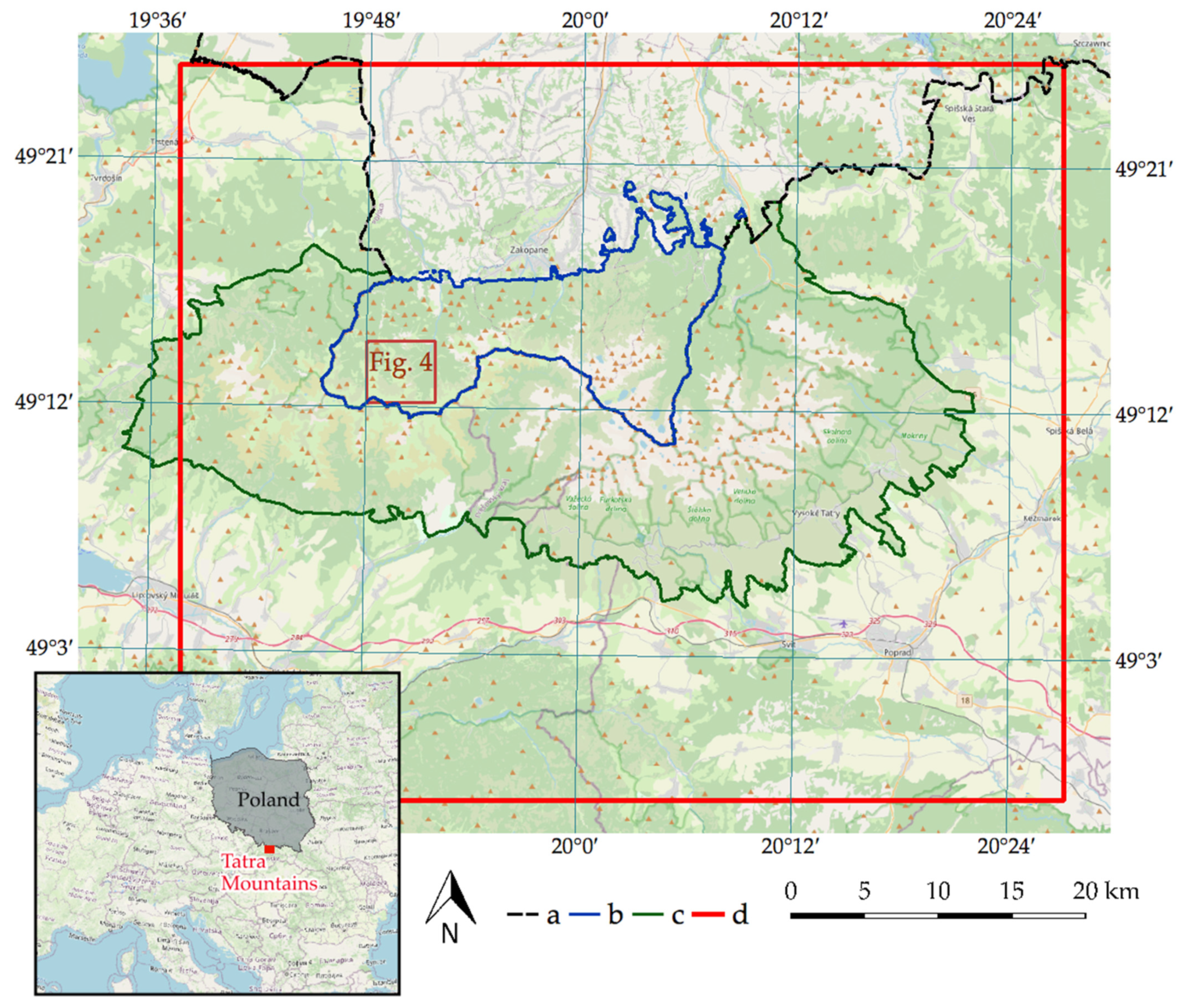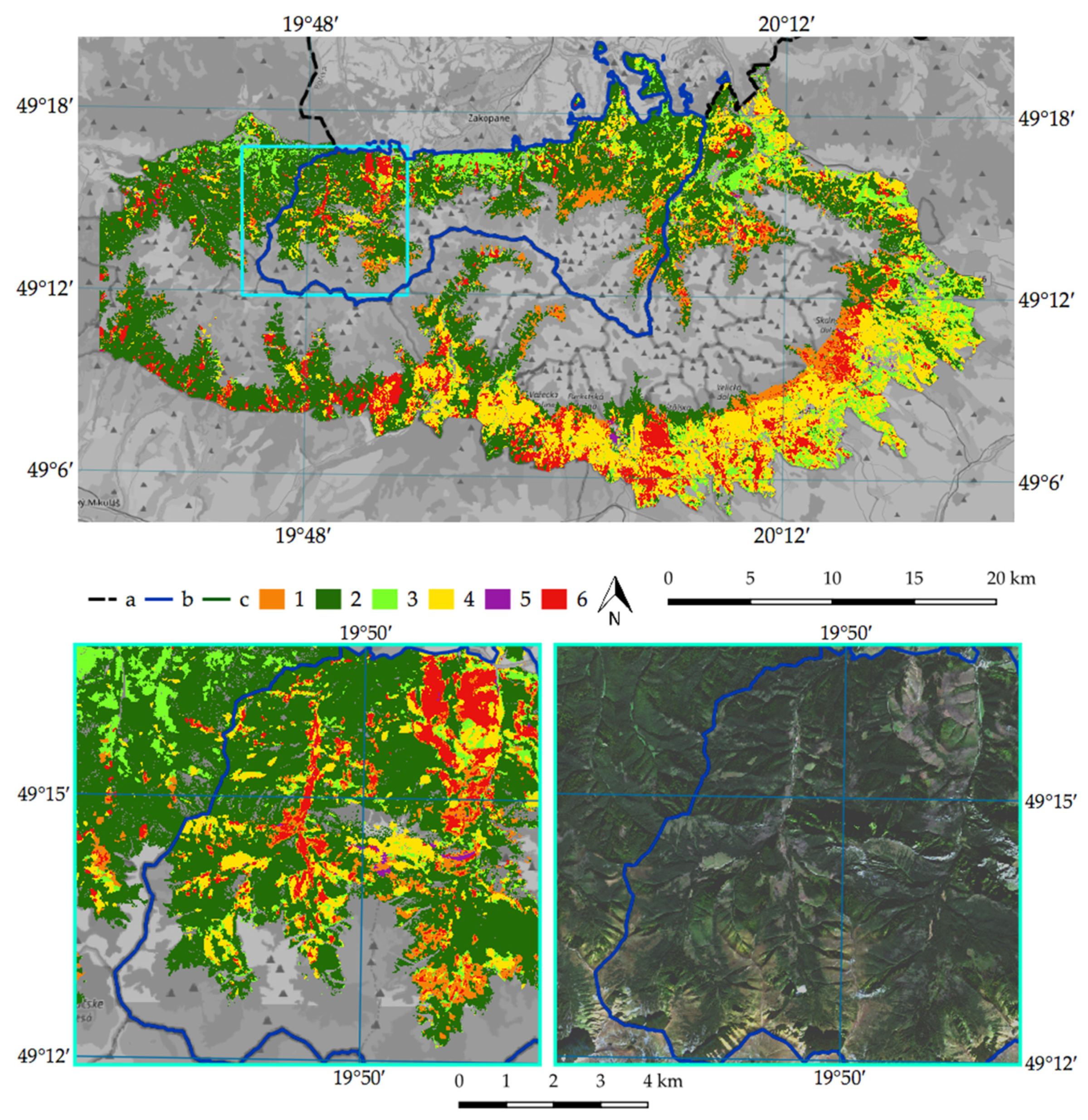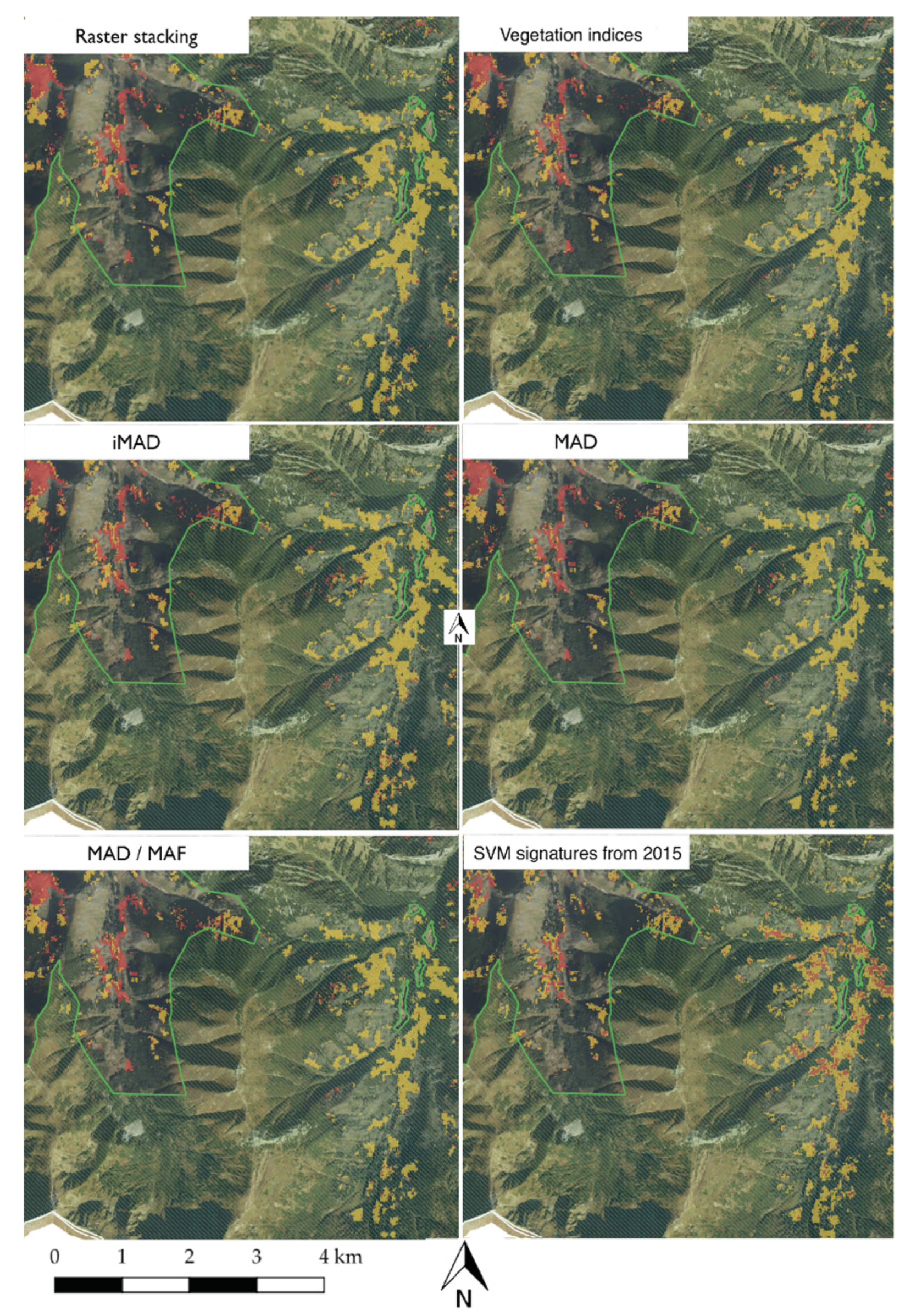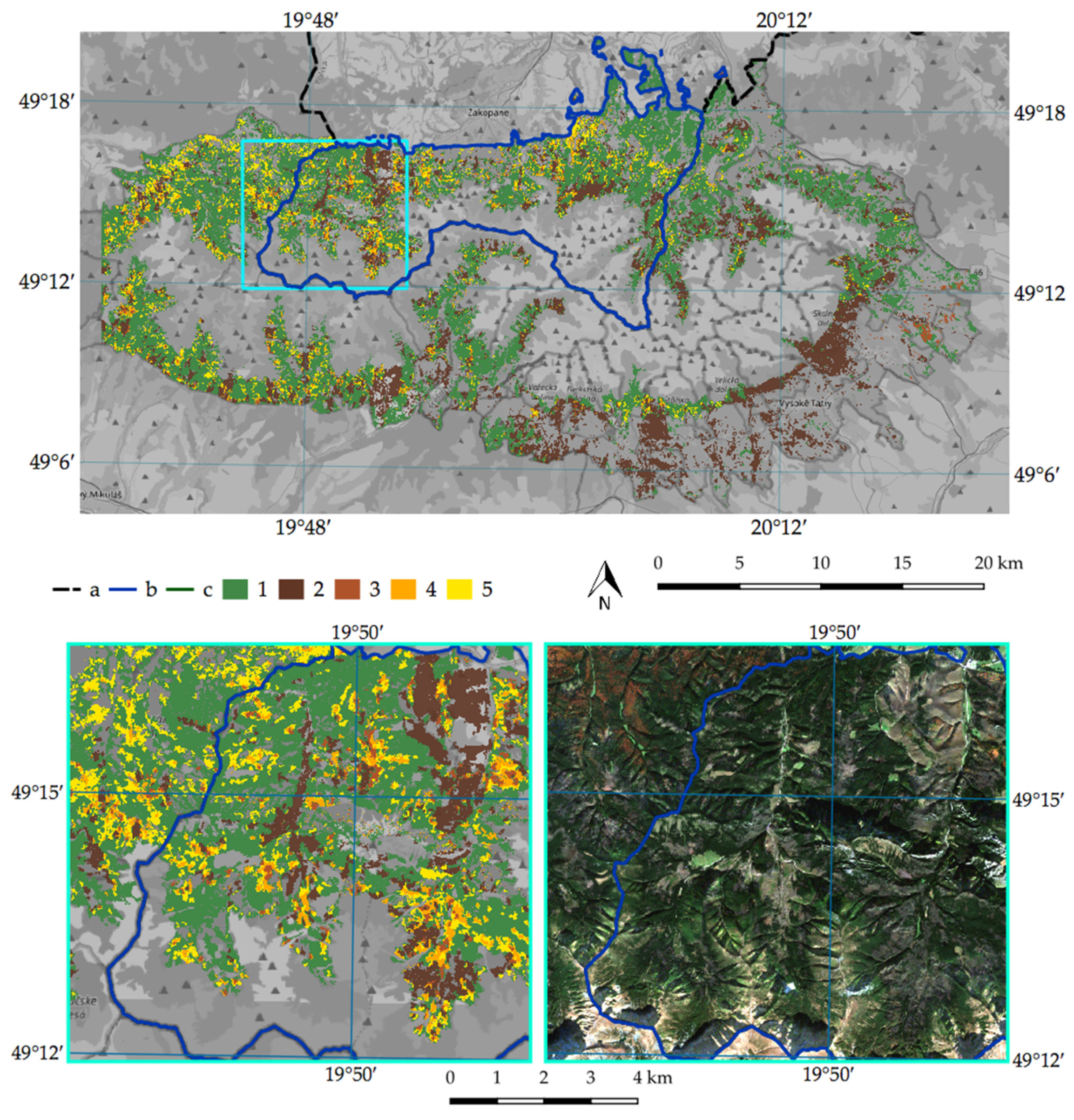Assessment of Sentinel-2 Images, Support Vector Machines and Change Detection Algorithms for Bark Beetle Outbreaks Mapping in the Tatra Mountains
Abstract
:1. Introduction
2. Research Area and Targets
3. Materials and Methods
- WorldView-2 satellite image with a resolution of 0.5–2 m acquired on 7 September 2015;
- airborne orthophotomap (0.25 m; 2 October 2017);
- shapefiles of damaged forest stands by bark beetles (update for 2017), sanitary cuttings carried out in the park (updated for 2017), boundaries of protection zones, forest areas, windthrow and a forest map of the TPN area.
- a high-resolution WorldView-2 image;
- a vector layer updated for 2015: snags, sanitary cuts and windthrow and other forest parameters of TPN (all vector data were field verified).
- an actual airborne orthophotomap (acquired on 2 October 2017 with an accuracy of 0.25 m);
- an updated vector layer of snags, sanitary cuts and windthrow, which allowed us to assess changes between 2015 and 2017 (Table 2).
- no changes between 2015 and 2017 (an undisturbed coniferous forest in 2015 remains undisturbed in 2017);
- dieback of trees—undisturbed coniferous forest in 2015, and dying in 2017;
- deforestation (sanitary cuts) or windthrow, undisturbed coniferous forest in 2015, and nonexistent in 2017 (this class may also include gaps in the stand, e.g., due to old age).
3.1. Classification
3.2. Multi-Temporal Analyses
- remote-sensing indices (Table 3);
- Sentinel-2 spectral signatures used from 2015 SVM classification to analyze class changes in 2017;
- Multivariate Alteration Detection (MAD);
- Multivariate Alteration Detection/Maximum Autocorrelation Factor (MAD/MAF);
- Iteratively Re-weighted Multivariate Alteration Detection (iMAD);
- raster stacking method of combining the 2015 and 2017 periods into one 20-band raster; 10 spectral bands acquired in 2015 and an additional 10 bands from 2017. The following spectral bands were used: 2 (Blue), 3 (Green), 4 (Red), 5 (Red Edge 1), 6 (Red Edge 2), 7 (Red Edge 3), 8 (NIR), 8A (narrow NIR), 11 (SWIR), 12 (SWIR); twenty-meter bands were resampled using the nearest neighbor method to a ten-meter pixel size.
3.3. Map of Bark Beetle Outbreaks and Assessment of Classification Quality
4. Results
5. Discussion
6. Conclusions
Author Contributions
Funding
Institutional Review Board Statement
Informed Consent Statement
Data Availability Statement
Acknowledgments
Conflicts of Interest
References
- Caudullo, G.; Tinner, W.; de Rigo, D. Picea abies in Europe: Distribution, habitat, usage and threats. In European Atlas of Forest Tree Species; San-Miguel-Ayanz, J., de Rigo, D., Caudullo, G., Houston Durrant, T., Mauri, A., Eds.; The Publications Office of the European Union: Luxembourg, 2016; p. e012300+. Available online: https://forest.jrc.ec.europa.eu/media/atlas/Picea_abies.pdf (accessed on 15 July 2021).
- Bjerreskov, K.; Nord-Larsen, T.; Fensholt, R. Classification of Nemoral Forests with Fusion of Multi-Temporal Sentinel-1 and 2 Data. Remote Sens. 2021, 13, 950. [Google Scholar] [CrossRef]
- Wermelinger, B. Ecology and management of the spruce bark beetle Ips typographus—A review of recent research. For. Ecol. Manag. 2004, 202, 67–82. [Google Scholar] [CrossRef]
- Grodzki, W.; Fronek, W.G. Occurrence of Ips typographus (L.) after wind damage in the Kościeliska Valley of the Tatra National Park. For. Res. Pap. 2017, 78, 113–119. [Google Scholar] [CrossRef] [Green Version]
- Seidl, R.; Thom, D.; Kautz, M.; Martin-Benito, D.; Peltoniemi, M.; Vacchiano, G.; Wild, J.; Ascoli, D.; Petr, M.; Honkaniemi, J.; et al. disturbances under climate change. Nat. Clim. Chang. 2017, 7, 395–402. [Google Scholar] [CrossRef] [Green Version]
- Seidl, R.; Schelhaas, M.-J.; Lexer, M.J. Unraveling the drivers of intensifying forest disturbance regimes in Europe. Glob. Chang. Biol. 2011, 17, 2842–2852. [Google Scholar] [CrossRef]
- Grodzki, W.; Turčáni, M.; Jakuš, R.; Hlásny, T.; Raši, R.; McManus, M.L. Bark beetles in the Tatra Mountains. International research 1998–2005—An overview. Folia For. Pol. Ser. A 2010, 52, 114–130. [Google Scholar] [CrossRef]
- Abdullah, H.; Skidmore, A.K.; Darvishzadeh, R.; Heurich, M. Sentinel-2 accurately maps green-attack stage of European spruce bark beetle (Ips typographus, L.) compared with Landsat-8. Remote Sens. Ecol. Conserv. 2019, 5, 87–106. [Google Scholar] [CrossRef] [Green Version]
- Lausch, A.; Heurich, M.; Fahse, L. Spatio-temporal infestation patterns of Ips typographus (L.) in the Bavarian Forest National Park, Germany. Ecol. Indic. 2013, 31, 73–81. [Google Scholar] [CrossRef]
- Heurich, M. Progress of forest regeneration after a large-scale Ips typographus outbreak in the subalpine Picea abies forests of the Bavarian Forest National Park. Silva Gabreta 2009, 15, 49–66. [Google Scholar]
- Przybylska, K.; Kucharczyk, S. Lasy górskich parków narodowych jako przedmiot ochrony i obiekt badań naturalnych procesów lasotwórczych. Rocz. Bieszcz. 2007, 15, 15–33. [Google Scholar]
- Zagajewski, B.; Kluczek, M.; Raczko, E.; Njegovec, A.; Dabija, A.; Kycko, M. Comparison of Random Forest, Support Vector Machines, and Neural Networks for Post-Disaster Forest Species Mapping of the Krkonoše/Karkonosze Transboundary Biosphere Reserve. Remote Sens. 2021, 13, 2581. [Google Scholar] [CrossRef]
- Immitzer, M.; Vuolo, F.; Atzberger, C. First Experience with Sentinel-2 Data for Crop and Tree Species Classifications in Central Europe. Remote Sens. 2016, 8, 166. [Google Scholar] [CrossRef]
- Raczko, E.; Zagajewski, B. Tree Species Classification of the UNESCO Man and the Biosphere Karkonoski National Park (Poland) Using Artificial Neural Networks and APEX Hyperspectral Images. Remote Sens. 2018, 10, 1111. [Google Scholar] [CrossRef] [Green Version]
- Wessel, M.; Brandmeier, M.; Tiede, D. Evaluation of Different Machine Learning Algorithms for Scalable Classification of Tree Types and Tree Species Based on Sentinel-2 Data. Remote Sens. 2018, 10, 1419. [Google Scholar] [CrossRef] [Green Version]
- Brown, L.A.; Ogutu, B.O.; Dash, J. Estimating Forest Leaf Area Index and Canopy Chlorophyll Content with Sentinel-2: An Evaluation of Two Hybrid Retrieval Algorithms. Remote Sens. 2019, 11, 1752. [Google Scholar] [CrossRef] [Green Version]
- Ochtyra, A. Forest Disturbances in Polish Tatra Mountains for 1985–2016 in Relation to Topography, Stand Features, and Protection Zone. Forests 2020, 11, 579. [Google Scholar] [CrossRef]
- Hawryło, P.; Bednarz, B.; Wężyk, P.; Szostak, M. Estimating defoliation of Scots pine stands using machine learning methods and vegetation indices of Sentinel-2. Eur. J. Remote Sens. 2018, 51, 194–204. [Google Scholar] [CrossRef] [Green Version]
- Senf, C.; Seidl, R.; Hostert, P. Remote sensing of forest insect disturbances: Current state and future directions. Int. J. Appl. Earth Obs. Geoinf. 2017, 60, 49–60. [Google Scholar] [CrossRef] [Green Version]
- Liang, L.; Hawbaker, T.J.; Zhu, Z.; Li, X.; Gong, P. Forest disturbance interactions and successional pathways in the Southern Rocky Mountains. For. Ecol. Manag. 2016, 375, 35–45. [Google Scholar] [CrossRef] [Green Version]
- Meddens, A.J.H.; Hicke, J.A.; Vierling, L.A.; Hudak, A.T. Evaluating methods to detect bark beetle-caused tree mortality using single-date and multi-date Landsat imagery. Remote Sens. Environ. 2013, 132, 49–58. [Google Scholar] [CrossRef]
- Havašová, M.; Bucha, T.; Ferenčík, J.; Jakuš, R. Applicability of a vegetation indices-based method to map bark beetle outbreaks in the High Tatra Mountains. Ann. For. Res. 2015, 58, 295–310. [Google Scholar] [CrossRef]
- Mikusiński, G.; Bubnicki, J.W.; Churski, M.; Czeszczewik, D.; Walankiewicz, W.; Kuijper, D.P.J. Is the impact of loggings in the last primeval lowland forest in Europe underestimated? The conservation issues of Białowieża Forest. Biol. Conserv. 2018, 227, 266–274. [Google Scholar] [CrossRef]
- Immitzer, M.; Atzberger, C. Early Detection of Bark Beetle Infestation in Norway Spruce (Picea abies, L.) using WorldView-2 Data; Frühzeitige Erkennung von Borkenkä ferbefall an Fichten mittels WorldView-2 Satellitendaten. Photogramm. Fernerkund. Geoinf. 2014, 5, 351–367. [Google Scholar] [CrossRef]
- Kycko, M.; Zagajewski, B.; Zwijacz-Kozica, M.; Cierniewski, J.; Romanowska, E.; Orłowska, K.; Ochtyra, A.; Jarocińska, A. Assessment of Hyperspectral Remote Sensing for Analyzing the Impact of Human Trampling on Alpine Swards. Mt. Res. Dev. 2017, 37, 66–74. [Google Scholar] [CrossRef] [Green Version]
- Sproull, G.J.; Bukowski, M.; Mcnutt, N.; Zwijacz-Kozica, T.; Szwagrzyk, J. Landscape-Level Spruce Mortality Patterns and Topographic Forecasters of Bark Beetle Outbreaks in Managed and Unmanaged Forests of the Tatra Mountains. Pol. J. Ecol. 2017, 65, 24–37. [Google Scholar] [CrossRef]
- Holeksa, J.; Jaloviar, P.; Kucbel, S.; Saniga, M.; Svoboda, M.; Szewczyk, J.; Szwagrzyk, J.; Zielonka, T.; Żywiec, M. Models of disturbance driven dynamics in the West Carpathian spruce forests. For. Ecol. Manag. 2017, 388, 79–89. [Google Scholar] [CrossRef]
- Nikolov, C.; Konôpka, B.; Kajba, M.; Galko, J.; Kunca, A.; Janský, L. Post-disaster Forest Management and Bark Beetle Outbreak in Tatra National Park, Slovakia. Mt. Res. Dev. 2014, 34, 326–335. [Google Scholar] [CrossRef]
- Kaufman, Y.J.; Tanre, D. Atmospherically resistant vegetation index (ARVI) for EOS-MODIS. IEEE Trans. Geosci. Remote Sens. 1992, 30, 261–270. [Google Scholar] [CrossRef]
- Yang, C.; Everitt, J.H.; Bradford, J.M.; Murden, D. Airborne Hyperspectral Imagery and Yield Monitor Data for Mapping Cotton Yield Variability. Precis. Agric. 2004, 5, 445–461. [Google Scholar] [CrossRef]
- Gitelson, A.A.; Kaufman, Y.J.; Merzlyak, M.N. Use of a green channel in remote sensing of global vegetation from EOS-MODIS. Remote Sens. Environ. 1996, 58, 289–298. [Google Scholar] [CrossRef]
- Huete, A.A.; Liu, H.Q.; Batchily, K.; van Leeuwen, W. A comparison of vegetation indices over a global set of TM images for EOS-MODIS. Remote Sens. Environ. 1997, 59, 440–451. [Google Scholar] [CrossRef]
- Miura, T.; Yoshioka, H.; Fujiwara, K.; Yamamoto, H. Inter-Comparison of ASTER and MODIS Surface Reflectance and Vegetation Index Products for Synergistic Applications to Natural Resource Monitoring. Sensors 2008, 8, 2480. [Google Scholar] [CrossRef] [PubMed] [Green Version]
- Sripada, R.P.; Heiniger, R.W.; White, J.G.; Meijer, A.D. Aerial Color Infrared Photography for Determining Early In-Season Nitrogen Requirements in Corn. Agron. J. 2006, 98, 968–977. [Google Scholar] [CrossRef]
- Rouse, W.; Haas, R.H.; Deering, D.W. Monitoring Vegetation Systems in the Great Plains with ERTS, NASA SP-351. Third ERTS-1 Symp. In NASA Special Publication; NASA: Washington, DC, USA, 1974; Volume 1, pp. 309–317. [Google Scholar]
- Hunt, E.R.; Cavigelli, M.; Daughtry, C.S.T.; Mcmurtrey, J.E.; Walthall, C.L. Evaluation of Digital Photography from Model Aircraft for Remote Sensing of Crop Biomass and Nitrogen Status. Precis. Agric. 2005, 6, 359–378. [Google Scholar] [CrossRef]
- Huete, A.R. A soil-adjusted vegetation index (SAVI). Remote Sens. Environ. 1988, 25, 295–309. [Google Scholar] [CrossRef]
- Gobron, N.; Pinty, B.; Verstraete, M.M.; Widlowski, J.-L. Advanced vegetation indices optimized for up-coming sensors: Design, performance, and applications. IEEE Trans. Geosci. Remote Sens. 2000, 38, 2489–2505. [Google Scholar] [CrossRef]
- Vincini, M.; Frazzi, E.; D’Alessio, P. A broad-band leaf chlorophyll vegetation index at the canopy scale. Precis. Agric. 2008, 9, 303–319. [Google Scholar] [CrossRef]
- Datt, B. A New Reflectance Index for Remote Sensing of Chlorophyll Content in Higher Plants: Tests using Eucalyptus Leaves. J. Plant Physiol. 1999, 154, 30–36. [Google Scholar] [CrossRef]
- Daughtry, C.S.T.; Walthall, C.L.; Kim, M.S.; de Colstoun, E.B.; McMurtrey III, J.E. Estimating Corn Leaf Chlorophyll Concentration from Leaf and Canopy Reflectance. Remote Sens. Environ. 2000, 74, 229–239. [Google Scholar] [CrossRef]
- Haboudane, D.; Miller, J.R.; Pattey, E.; Zarco-Tejada, P.J.; Strachan, I.B. Hyperspectral vegetation indices and novel algorithms for predicting green LAI of crop canopies: Modeling and validation in the context of precision agriculture. Remote Sens. Environ. 2004, 90, 337–352. [Google Scholar] [CrossRef]
- Zagajewski, B.; Kycko, M.; Tømmervik, H.; Bochenek, Z.; Wojtuń, B.; Bjerke, J.W.; Kłos, A. Feasibility of hyperspectral vegetation indices for the detection of chlorophyll concentration in three high Arctic plants: Salix polaris, Bistorta vivipara, and Dryas octopetala. Acta Soc. Bot. Pol. 2018, 87, 3604. [Google Scholar] [CrossRef]
- Metternicht, G. Vegetation indices derived from high-resolution airborne videography for precision crop management. Int. J. Remote Sens. 2003, 24, 2855–2877. [Google Scholar] [CrossRef]
- Galvão, L.S.; Formaggio, A.R.; Tisot, D.A. Discrimination of sugarcane varieties in Southeastern Brazil with EO-1 Hyperion data. Remote Sens. Environ. 2005, 94, 523–534. [Google Scholar] [CrossRef]
- Hunt Jr., E.; Rock, B. Detection of changes in leaf water content using Near- and Middle-Infrared reflectances☆. Remote Sens. Environ. 1989, 30, 43–54. [Google Scholar] [CrossRef]
- Trombetti, M.; Riano, D.; Rubio, M.; Cheng, Y.; Ustin, S. Multi-temporal vegetation canopy water content retrieval and interpretation using artificial neural networks for the continental USA. Remote Sens. Environ. 2008, 112, 203–215. [Google Scholar] [CrossRef]
- Hardisky, M.; Klemas, V.; Smart, R. The Influences of Soil Salinity, Growth Form, and Leaf Moisture on the Spectral Reflectance of Spartina Alterniflora Canopies. Photogramm. Eng. Remote Sens. 1983, 49, 77–83. [Google Scholar]
- Cocke, A.E.; Fulé, P.Z.; Crouse, J.E. Comparison of burn severity assessments using Differenced Normalized Burn Ratio and ground data. Int. J. Wildl. Fire 2005, 14, 189–198. [Google Scholar] [CrossRef] [Green Version]
- Caret: Classification and Regression Training; R Package Version 6.0-86. Available online: https://rdrr.io/cran/caret/ (accessed on 20 January 2020).
- Gaujoux, R. Rngtools: Utility Functions for Working with Random Number Generators; R Package Version 1.5. 2020. Available online: https://rdrr.io/rforge/rngtools/ (accessed on 20 January 2020).
- Wickham, H.; François, R.; Henry, L.; Müller, K. Dplyr: A Grammar of Data Manipulation; R Package Version 1.0.0. 2020. Available online: https://rdrr.io/cran/dplyr/ (accessed on 20 January 2020).
- Nielsen, A.A.; Conradsen, K.; Simpson, J.J. Multivariate Alteration Detection (MAD) and MAF Postprocessing in Multispectral, Bitemporal Image Data: New Approaches to Change Detection Studies. Remote Sens. Environ. 1998, 64, 1–19. [Google Scholar] [CrossRef] [Green Version]
- Yan, L.; Xia, W.; Zhao, Z.; Wang, Y. A Novel Approach to Unsupervised Change Detection Based on Hybrid Spectral Difference. Remote Sens. 2018, 10, 841. [Google Scholar] [CrossRef] [Green Version]
- Switzer, P.; Green, A.A. Min/Max Autocorrelation Factors for Multivariate Spatial Imagery; Technical Report SWI NSF 6; Stanford University: Stanford, CA, USA, 1984; p. 16. [Google Scholar]
- Nielsen, A.A. The Regularized Iteratively Reweighted MAD Method for Change Detection in Multi- and Hyperspectral Data. IEEE Trans. Image Process. 2007, 16, 463–478. [Google Scholar] [CrossRef] [Green Version]
- Meyer, D.; Dimitriadou, E.; Hornik, K.; Weingessel, A.; Leisch, F. e1071: Misc Functions of the Department of Statistics, Probability Theory Group (Formerly: E1071); R Package Version 1.7-3; TU: Wien, Austria, 2019; Available online: https://rdrr.io/rforge/e1071/ (accessed on 20 January 2020).
- Zhan, Z.; Yu, L.; Li, Z.; Ren, L.; Gao, B.; Wang, L.; Luo, Y. Combining GF-2 and Sentinel-2 Images to Detect Tree Mortality Caused by Red Turpentine Beetle during the Early Outbreak Stage in North China. Forests 2020, 11, 172. [Google Scholar] [CrossRef] [Green Version]
- Yu, L.; Huang, J.; Zong, S.; Huang, H.; Luo, Y. Detecting Shoot Beetle Damage on Yunnan Pine Using Landsat Time-Series Data. Forests 2018, 9, 39. [Google Scholar] [CrossRef] [Green Version]
- Marx, A.; Kleinschmit, B. Sensitivity analysis of RapidEye spectral bands and derived vegetation indices for insect defoliation detection in pure Scots pine stands. iForest-Biogeosci. For. 2017, 10, 659–668. [Google Scholar] [CrossRef] [Green Version]
- Näsi, R.; Honkavaara, E.; Blomqvist, M.; Lyytikäinen-Saarenmaa, P.; Hakala, T.; Viljanen, N.; Kantola, T.; Holopainen, M. Remote sensing of bark beetle damage in urban forests at individual tree level using a novel hyperspectral camera from UAV and aircraft. Urban For. Urban Green. 2018, 30, 72–83. [Google Scholar] [CrossRef]
- Rębiś, P. Assessment of Nonparametric Algorithms for Deadwood Identification on the HySpex Hyperspectral Aerial Image. Master’s Thesis, University of Warsaw, Faculty of Geography and Regional Studies, Warsaw, Poland, 16 July 2018; p. 73. [Google Scholar]
- Dabija, A.; Kluczek, M.; Zagajewski, B.; Raczko, E.; Kycko, M.; Al-Sulttani, A.H.; Tardà, A.; Pineda, L.; Corbera, J. Comparison of Support Vector Machines and Random Forests for Corine Land Cover Mapping. Remote Sens. 2021, 13, 777. [Google Scholar] [CrossRef]
- Kycko, M.; Zagajewski, B.; Lavender, S.; Dabija, A. In Situ Hyperspectral Remote Sensing for Monitoring of Alpine Trampled and Recultivated Species. Remote Sens. 2019, 11, 1296. [Google Scholar] [CrossRef] [Green Version]
- Marcinkowska-Ochtyra, A.; Zagajewski, B.; Raczko, E.; Ochtyra, A.; Jarocińska, A. Classification of High-Mountain Vegetation Communities within a Diverse Giant Mountains Ecosystem Using Airborne APEX Hyperspectral Imagery. Remote Sens. 2018, 10, 570. [Google Scholar] [CrossRef] [Green Version]








| Class | Number of Reference Polygons | Number of Reference Pixels |
|---|---|---|
| Coniferous forests | 39 | 9892 |
| Deciduous forests | 26 | 3114 |
| Grasslands | 60 | 9291 |
| Rocks | 40 | 9443 |
| Snags | 40 | 2347 |
| Cuts or windthrow | 32 | 5440 |
| Class | Number of Reference Polygons | Number of Reference Pixels |
|---|---|---|
| No changes | 40 | 21,301 |
| Dieback of trees | 48 | 1260 |
| Cuts or windthrow | 52 | 1865 |
| Index | Formula | Reference |
|---|---|---|
| Atmospherically Resistant Vegetation Index (ARVI) | [29] | |
| Blue Normalized Difference Vegetation Index (BNDVI) | [30] | |
| Green Normalized Difference Vegetation Index (GNDVI) | [31] | |
| Enhanced Vegetation Index (EVI) | [32] | |
| Enhanced Vegetation Index 2 (EVI 2) | [33] | |
| Green Soil Adjusted Vegetation Index (GSAVI) | [34] | |
| Normalized Difference Vegetation Index (NDVI) | [35] | |
| Normalized Green-Red Difference Index (NGRDI) | [36] | |
| Soil Adjusted Vegetation Index (SAVI) | [37] | |
| Simple Ratio / Short Wave Infrared (SR/SWIR) | [8] | |
| Green Leaf Index (GLI) | [38] | |
| Chlorophyll Vegetation Index (CVI) | [39] | |
| Leaf Chlorophyll Index (LCI) | [40] | |
| Modified Chlorophyll Absorption in Reflectance Index (MCARI) | [41] | |
| Modified Chlorophyll Absorption in Reflectance Index 2 (MCARI 2) | [42,43] | |
| Normalized Difference Red-Edge 2 (NDRE 2) | [8] | |
| Transformed Chlorophyll Absorption Radio Index (TCARI) | [42] | |
| Plant Pigment Ratio (PPR) | [44] | |
| Disease Water Stress Index (DSWI) | [45] | |
| Moisture Stress Index (MSI) | [46] | |
| Moisture Stress Index 2 (MSI 2) | [47] | |
| Normalized Difference Infrared Index (NDII) | [48] | |
| Normalized Difference Infrared Index 2 (NDII 2) Normalized Burn Ratio (NBR) | [49] |
| Reference Data | UA (%) | ||||||
|---|---|---|---|---|---|---|---|
| Snags | Coniferous Forest | Deciduous Forest | Grasslands | Rocks | Cuts or Windthrow | ||
| Snags | 5410 | 1 | 1 | 29 | 80 | 474 | 90.2 |
| Coniferous forests | 2 | 24,958 | 52 | 1 | 97 | 2 | 99.4 |
| Deciduous forests | 0 | 113 | 6872 | 181 | 0 | 37 | 95.4 |
| Grasslands | 12 | 0 | 191 | 20,080 | 18 | 490 | 96.6 |
| Rocks | 23 | 0 | 0 | 2 | 22,054 | 46 | 99.7 |
| Cuts or windthrow | 211 | 2 | 1 | 597 | 131 | 11,798 | 92.6 |
| PA (%) | 95.6 | 99.5 | 96.6 | 96.1 | 98.5 | 91.8 | |
| Class | Area (km2) | Percentage (%) |
|---|---|---|
| Snags | 48.65 | 9.21 |
| Coniferous forests (c forest) | 223.39 | 42.27 |
| Deciduous forests | 66.54 | 12.59 |
| Grasslands | 120.93 | 22.88 |
| Rocks | 1.89 | 0.36 |
| Cuts or windthrow | 67.08 | 12.69 |
| Method | OA (%) | Kappa Coefficient | Snags F1-Score (%) | Coniferous Forests F1-Score (%) | Cuts or Windthrow F1-Score (%) |
|---|---|---|---|---|---|
| Raster stacking | 99.1 | 0.97 | 96.9 | 99.8 | 95.2 |
| Remote sensing indices | 99.0 | 0.97 | 96.4 | 99.9 | 93.8 |
| iMAD | 99.0 | 0.97 | 96.3 | 99.9 | 93.6 |
| MAD | 98.5 | 0.96 | 95.2 | 99.4 | 93.8 |
| MAD/MAF | 98.5 | 0.96 | 95.1 | 99.4 | 93.7 |
| Spectral features obtained from Sentinel-2 2015 and SVM classified on Sentinel-2 2017 | 93.8 | 0.77 | 70.4 | 99.8 | 58.8 |
| Class | TPN (ha) | TANAP (ha) | Sum (ha) |
|---|---|---|---|
| Undisturbed coniferous forest | 6014.46 | 13,546.43 | 19,560.89 |
| Snags | 726.47 | 822.00 | 1548.47 |
| Cuts or windthrow | 236.18 | 951.64 | 1187.82 |
| Reference | Sensor | Research Target | Classification Method | OA (%) | Snags PA (%) | Snags UA (%) |
|---|---|---|---|---|---|---|
| [23] | Sentinel-2 | Ips tyhographus, snags | SVM | 97 | 91.71 | 90.72 |
| [21] | Landsat TM, ETM+ | Dendroctonus ponderosae, snags | ML | 91 | 88.3 | 93.7 |
| [24] | WorldView-2 | Ips tyhographus, green phase of the bark beetle attack and snags | RF | 76.2 | 100 | 100 |
| [22] | Landsat TM, ETM+ | Ips typographus, snags. | MSI, VCI, NDMI–threshold | 94 | ||
| [59] | Landsat TM, ETM+, OLI | Tomicus yunnanensis and Tomicus minor | MSI | 86.38 | ||
| [62] | WorldView-2 | Ips tyhographus, snags, mountain pine. | SVM | 86.6 | 86.75 | 100 |
| [58] | Sentinel-2 | Dendroctonus valens: three classes: 0%, 0–15%, 15–50% of dead trees | SVM | 59.5 | - | - |
| [58] | Sentinel-2 | Dendroctonus valens: two classes: 0%, 15–50% | SVM | 81 | - | - |
| [58] | GaoFen-2 | as above, additionally: alive, attacked and dead tree | SVM | 77.7 | - | - |
| the current study | Sentinel-2 | Ips tyhographus, snags, cuts and windthrow | SVM | 97.2 | 95.6 | 90.2 |
Publisher’s Note: MDPI stays neutral with regard to jurisdictional claims in published maps and institutional affiliations. |
© 2021 by the authors. Licensee MDPI, Basel, Switzerland. This article is an open access article distributed under the terms and conditions of the Creative Commons Attribution (CC BY) license (https://creativecommons.org/licenses/by/4.0/).
Share and Cite
Migas-Mazur, R.; Kycko, M.; Zwijacz-Kozica, T.; Zagajewski, B. Assessment of Sentinel-2 Images, Support Vector Machines and Change Detection Algorithms for Bark Beetle Outbreaks Mapping in the Tatra Mountains. Remote Sens. 2021, 13, 3314. https://doi.org/10.3390/rs13163314
Migas-Mazur R, Kycko M, Zwijacz-Kozica T, Zagajewski B. Assessment of Sentinel-2 Images, Support Vector Machines and Change Detection Algorithms for Bark Beetle Outbreaks Mapping in the Tatra Mountains. Remote Sensing. 2021; 13(16):3314. https://doi.org/10.3390/rs13163314
Chicago/Turabian StyleMigas-Mazur, Robert, Marlena Kycko, Tomasz Zwijacz-Kozica, and Bogdan Zagajewski. 2021. "Assessment of Sentinel-2 Images, Support Vector Machines and Change Detection Algorithms for Bark Beetle Outbreaks Mapping in the Tatra Mountains" Remote Sensing 13, no. 16: 3314. https://doi.org/10.3390/rs13163314
APA StyleMigas-Mazur, R., Kycko, M., Zwijacz-Kozica, T., & Zagajewski, B. (2021). Assessment of Sentinel-2 Images, Support Vector Machines and Change Detection Algorithms for Bark Beetle Outbreaks Mapping in the Tatra Mountains. Remote Sensing, 13(16), 3314. https://doi.org/10.3390/rs13163314









